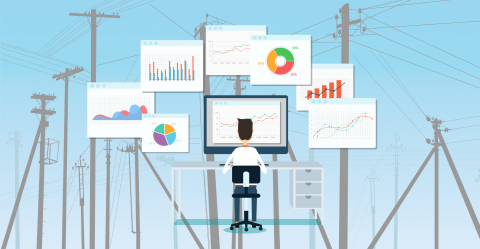
Is just saying “analytics” enough to generate actionable insight?
Nov 04, 2021We often discuss how to leverage the information from the low voltage grid available through smart meters. And, often, we will say “analytics” as if saying the word will reveal the secrets of the universe. In fact, it could be “analytics” we say, but it might be “AI” or “Big Data” or……. Well, sadly, our industry is full of buzzwords that appear to simplify complex problems without providing tangible steps forwards.
Lets take “analytics”, and start with “where is the information we are analyzing?”
The low-voltage grid is largely unmonitored and unmanaged. As this is where much of change to support cleaner and sustainable living is taking place, we desperately need analytics here. The right smart meters provide sensors which can measure many parameters about network performance, and this is the foundation of allowing any analytics function to be developed for the low-voltage grid.
Let’s go a bit further and ask “how do we get the information so we can analyze it?”
Communications reliability is key here. Any smart meter which cannot prove to achieve more than 99% communications reliability is going to struggle when it comes to supporting an analytics function.
And, “what other information do we need to make sense of what we are analyzing?”
We can’t build an analytics solution which is dependent on reference data from elsewhere. We must be self-sufficient with the information we have. Solutions which rely on external systems with detailed knowledge of low-voltage grid topology, structure and physical implementation are not going to cut it. That information is hard to maintain and often not present at all.
And further still, let’s ask “how are we analyzing?”
Many big data tools generalise the analysis problem offering statistical tools and visualization approaches to help humans understand what they are seeing. Not good enough. We need tools that embed the electrical power engineering and physical rules that govern energy flows in grids. AI, by itself, is not enough – AI needs examples and time to “learning” before it can become effective. What is needed is AI coupled with the knowhow of engineers.
Let’s consider the outcomes and ask “what do we want to get from analyzing something?”
Nice graphical representations of data – are just that; simply “nice”. And that is where many big data or analytics tools stop. We talk about timely actionable insight. We need to know what to do in the grid, when to do it, how to quantifiably measure its success and, by measuring, improve the process.
The simple fact is that buzzwords don’t provide outcomes – they just help people categories a whole range of potential solutions, some of which might be practical.
We need to turn “analytics” into something which generates a business outcome through actionable and timely insight.
We need smart meters to be sensors generating the information and communications technologies to get the information, reliably, securely and at volume, to the analysis systems.
We need solutions which embed electrical engineering knowhow combined with AI, to build virtual low-voltage grid models, which can simulate various technical scenarios, especially for EV and PV/DER rollouts.
We need to be less dependent on having reference data available to perform the analysis; we need to be able to use what comes to us from the smart meters, and not have to maintain other data sets just to make the analysis work.
We need solutions which can recommend tangible actions that can be implemented in the field to achieve measurable and beneficial outcomes.
This is where NES is investing its effort.




